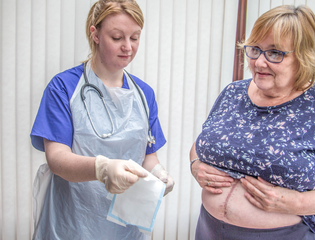Ovarian cancer tests
Testing and detecting ovarian cancer
The testing and diagnosis of ovarian cancer can be difficult. Unfortunately, ovarian cancer is often diagnosed in later stages, once symptoms have become more prominent. But there are a range of tests that can be done to help diagnose ovarian cancer.
Why is ovarian cancer difficult to screen for?
Unlike some other cancer types, we have no reliable screening tool for ovarian cancer. Our scientists are still figuring out exactly how and where ovarian cancer starts in order to be able to detect it in the earliest stages.
Additionally, ovarian cancer can be difficult to detect in its early stages, due to many of its symptoms being associated with other, much less serious conditions such as irritable bowel syndrome.
How is ovarian cancer diagnosed?
If you have any of the symptoms of ovarian cancer (including persistent tummy pain, persistent bloating, needing to wee more frequently or urgently, difficulty eating or feeling full more quickly), your GP should refer you for a CA125 blood test to check the level of a protein called CA125 in your blood.
Your GP will undertake an examination of your tummy and may also do an internal vaginal examination before they make this referral.
Tests that can help diagnose ovarian cancer
There is no national screening for ovarian cancer in the UK. This is because there isn’t a single test that reliably picks up ovarian cancer at an early stage.
However, a blood test and a scan can be used to try and determine if cancer is present in the ovaries. But other tests are often needed to effectively diagnose the disease.
Blood tests
CA125 is a protein that both women and men have in their blood. A high level of CA125 in your blood is a possible indicator of ovarian cancer, as CA125 can be produced by ovarian cancer cells.
A CA125 blood test is used to check the level of the CA125 protein in the blood to support the diagnosis of several things including ovarian cancer.
The CA125 test can either be carried out at your local doctor’s surgery, or you will be referred to your local hospital.
Ultrasounds
If your CA125 levels are elevated, your GP will refer to the radiology department of your local hospital for an ultrasound scan. There are two types of ultrasound scan which can help with a possible diagnosis of ovarian cancer: abdominal and pelvic/transvaginal.
Understand more about your how ultrasounds can detect ovarian cancer and how to interpret your results here.
CT scans
A CT scan is a test that takes detailed pictures of the inside of your body. In the case of ovarian cancer, a CT scan may be recommended to find out if symptoms you have been experiencing are caused by something more serious.
A CT scan usually takes place in a hospital and is carried out by a healthcare professional called a radiographer. The process usually takes between 10-20 minutes.
Fine-needle biopsy
A fine needle biopsy is where the doctor passes a thin needle through the skin using a CT or ultrasound (see above) to guide them into the right place. This process allows them to remove a small sample of cells or fluid from your ovaries to review the tissue under a microscope and run other tests on the cells in the sample.
Laparoscopy
A laparoscopy (otherwise known as keyhole surgery) biopsy is done under general anaesthetic. The surgeon makes 3 or 4 small cuts about 1cm long in your lower tummy to look at your ovaries using a camera on the end of a tube (the laparoscope). The process allows the surgeon to examine the area carefully and take biopsies if needed.
Laparotomy
Another option to detect ovarian cancer could be to have an operation called a laparotomy to get a biopsy. The surgeon uses one larger cut to open the lower abdominal to remove tissue or possibly your ovaries. This is only done if you and your doctor have discussed it and you have agreed to the operation beforehand.
Abdominal exams
During an abdominal exam, a doctor will press gently on different parts of the outside of your abdomen to feel for any masses or lumps. They may also listen to check your bowels are making normal noises. Most early ovarian cancers are difficult or impossible to feel though abdominal exams, but it is possible for the GP to feel if there is a mass, depending on factors such as the person’s size. It’s also possible for the GP to detect ascites (fluid collection) in this exam.
Pelvic exam
A pelvic exam is an internal vaginal examination, to check for any lumps, swelling or anything out of the ordinary in the pelvis, or lower abdomen. This involves the doctor inserting one or two fingers into the vagina, and they may press down on your lower tummy with their other hand at the same time. You can ask for a chaperone, either a member of staff or a friend, to be in the room during the examination.
X-ray
X-rays are rarely used in first diagnosing ovarian cancer, but they are sometimes used to see if cancer has spread elsewhere in the body. A chest x-ray can display tumors in the lungs, and fluid that has collected near the lungs, known as pleural effusion.
Detecting ovarian cancer early
Detection for ovarian cancer starts by seeing your GP if you are affected by any of the four key symptoms. Your GP will examine you and might refer you for tests or to see a specialist.
You should see your doctor if you notice a change that isn't normal for you. Or if you have any of the possible signs and symptoms of cancer. The symptom might not be due to cancer. But if it is, the earlier it's picked up the higher the chance of successful treatment.


